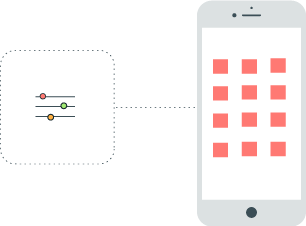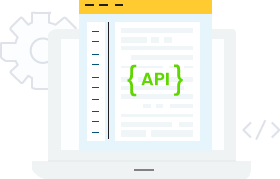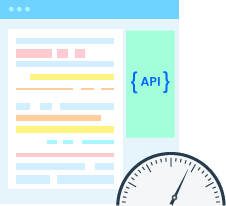API Integration is essential for communication between programs. Social media networking giants Facebook and Twitter are few companies that have created smart use of open or public APIs.
Basically, an open API is one in which an organization publishes its software to be shared freely. A startup, for instance, might want to open its API, as doing thus encourages third parties to use its software.

Large enterprises increasingly use APIs to integrate multiple systems with each other, usually new ones with the existing IT estate.That is why we’ve decided to share a few guidelines about how an API should look like to be a perfect fit for integration projects.
Characteristics of API that would be ideal for integration
1. Search by criteria
A good API should enable to search data by certain criteria, most significantly by its date. after the primary initial data synchronization, it’s generally the changes that we have a tendency to are principally interested in.
In alternative words, we want the modified (updated, deleted, corrected, etc.) or additional data since the last time we triggered the synchronization.
2. Authorization via OAuth:
OAuth is an open standard for authorization. OAuth provides significantly higher usability for the applying users/developers than the other methodology.
OAuth means if application users need to connect this application with another one via some integration services, they will authenticate themselves by explicitly granting this service access to the application.
3. Paging
Naturally, it will happen that there are huge amounts of data, although this is solely the modified data. So as to deal with it with efficiency, we want to own the simplest way to specify that we want not all the modified data in one sitting, but, say, only the primary “page” of it. As an example, of the scale one thousand information records.
A decent API should be ready to limit the amount of data that may be received in one go, in addition to the frequency of requests for data. It should even be ready to inform about what number “pages” of the data are left.
4. Documentation
There’s a massive quantity of APIs that are extremely poorly described, even those APIs that are actually very good for integration.
It’s very vital to provide solid documentation for integration projects. It’s one among the factors to reduce project implementation time, and hence, in prices for the project.
Reasons to choose API platform
1. API integration platform can create new apps with ease.

Many common apps at their core encompass previously existing technology that’s tied along during a distinctive fashion using APIs. Photo filters and social media technology existed before Instagram, however, they were able to package them along during a completely different means using APIs.
New apps may be composed in the exact same way. With the help of an API integration platform, groups will be able to connect existing integrations as APIs or micro-services to bring new apps to market.
2. API integration platform helps to connect cloud apps

A 2016 survey found that the everyday organization had thirteen cloud apps in place. Indeed, 15 percent of all corporations polled used Google Apps and/or workplace 365 at a minimum.
The gravity of apps has shifted to the cloud, and it no longer is smart to deal with the platform that connects of these clouds behind your firewall.Just have an API Integration platform born within the cloud to attach today’s modern cloud Apis.
3. Having API integration platform makes easier than managing each API individually.

By using more manual API creation strategies, even though the API itself was created by a 3rd party, oversight and maintenance of that API still fall on developers or other IT staff members within the enterprise.
As API use skyrockets, keeping tabs on all the APIs in place may be an exhausting and time-consuming effort.
API integration platforms, however, will considerably reduce this administrative burden. By serving as a single thing for all deployed and created APIs, this type of integration platform simplifies management, security and summary processes.
4. API integration platform for future-proofing enterprise integration.

Technology has progressed at a rapid phase over the past decade, and this growth shows no signs of slowing down. Some of the tech trends like Machine learning, wearables, and IOT poised to dramatically change the enterprise IT landscape in the future.
With an API integration in place, organizations can be sure they have the capabilities to effectively integrate these new technologies as they grow and mature.
5. API integration platform to quickly and easily create new APIs.

If you require an API, you have 2 main choices. You either used what was already out there (i.e., what a SaaS vendor or another third party already made) otherwise you built one from scratch.
Each scenario can be problematic. Assuming an API is available from an outside source, it might be restricted in its practicality or use. Building one from scratch via code is a way from ideal either, as that’s usually a time-consuming and tough task.
API integration platforms, however, now offer a third choice. With just the couple of clicks, you’ll produce an API from an existing integration saving you time and cash while additionally finally absolutely leveraging your existing technology investments.
Guide to design an API integration
selection should administrators or users set up the integration? Is it a single time setup or is ongoing interaction required? These factors will drive the optimal interface to present your users in choosing the services they want to connect with your app.
Authentication Have a workflow of authentication for each instance of an endpoint. Determine the kind of authentication mechanism the endpoint can use and also the workflow needed by the endpoint.
Do you keep the authenticated instance active? What’s the refresh key method for every end-point and the way can you manage the keys
Discover Many services offer a way to find the objects and information fields at the end to provide the data structure, field names, and formats that require to be mapped into your application.
You have to confirm which objects and data fields that are relevant to your application. Usually, this is often a subset of the available data at an end-point.
Data Mapping It’s a two-step process. The first one will be to provide default mapping from an endpoint’s standard data structure into your application’s data structure. The default mapping saves your users time by pre-mapping obvious information fields like name, address, postcode, etc.
The second step will be to provide your application’s users with the ability (generally through a UI) to map custom data objects and fields into your application. Through this UI you can also provide the ability to override your default mappings.
Data Transform Your app may use different types of formats like date, Time or other forms of data. Transformation services are required to convert the data between your app and the endpoint’s data structure to ensure the integrity of the data.
User Interaction Will users need to interactively engage with data within the endpoint? The user action may include choosing files, change or deleting data from the endpoint to provide a better experience for the user.
Synchronization Determine if you would like to synchronize data between your application and the endpoint.Endpoints backing webhooks that can be helpful to simplify the workflow of your application up-to-date with changes at the endpoint.
Log You need to collect usage and log data to support the integration. Identify how to handle alerts and notifications from the endpoint. APIs change frequently, focus on developing a strategy to stay ahead of changes introduced by the services you are connecting.
API integration is designed to make life easier. There’ll be a lot of intelligent systems ingesting data in real time. Build the functionality available to all different verticals.
APIs are more popular among large enterprises, it’s helpful to share data with their partners and to explore new market opportunities. like in the case of IoT or Mobile.
Contact us to develop custom API integrations for your existing applications.